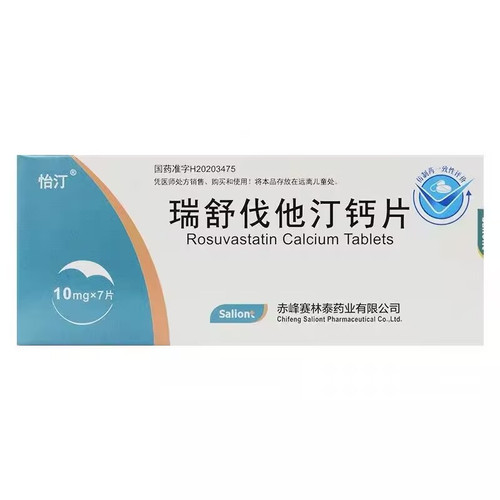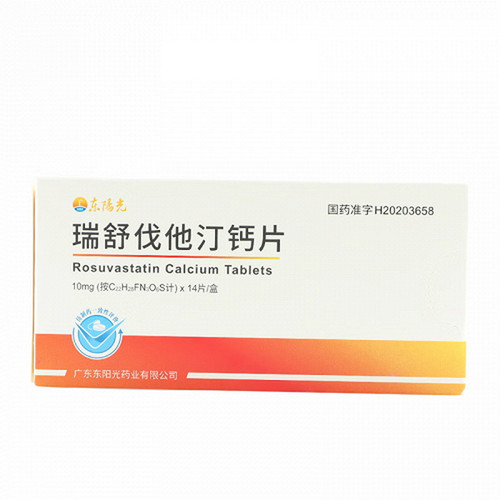Product Overview
[Drug Name]
Generic Name: Rosuvastatin Calcium Tablets
Trade Name: SANDOZ Rosuvastatin Calcium Tablets 10mg x 7 tablets
[Main Ingredients]
The main active ingredient of this product is rosuvastatin calcium.
[Indications/Main Functions]
This product is indicated for primary hypercholesterolemia (type A, including heterozygous familial hypercholesterolemia) or mixed dyslipidemia (type I), whose dyslipidemia is not adequately controlled with diet and other non-drug therapies (e.g., exercise therapy, weight loss). This product is also indicated for patients with homozygous familial hypercholesterolemia as an adjunct to diet and other lipid-lowering measures (e.g., LDL-C depletion therapy), or when these measures are inadequate.
[Specifications]
10mg x 7 tablets
[Dosage and Administration]
This product is taken orally, with or without food. Dosage: 100 mg twice daily for 12 weeks. This product must be taken concomitantly with the pharmacokinetic enhancers ritonavir, peginterferon alfa, and ribavirin. Recommended dosage and administration of peginterferon alfa (PEG-IFNa): Subcutaneous injection, 180 μg once weekly for 12 weeks (see the package insert for peginterferon alfa injection). Recommended dosage and administration of ribavirin: Oral, 1000 mg (weight < 75 kg) or 1200 mg (weight ≥ 75 kg) daily, divided into two doses, for 12 weeks (see the package insert for ribavirin).
[Adverse Reactions]
Adverse reactions observed with this product are generally mild and transient. In controlled clinical trials conducted internationally, less than 4% of patients withdrew due to adverse events. Immune system disorders are rare: allergic reactions, including angioedema. Nervous system disorders are common: headache, dizziness. Gastrointestinal disorders are common: constipation, nausea, abdominal pain. Skin and Abnormalities of lower limbs Rare: Itching, rash and urticaria Abnormalities of skeletal muscle, joints and bones Common: Myalgia Rare: Myopathy and rhabdomyolysis Systemic abnormalities Common: Weakness Like other HMG-COA reductase inhibitors, the incidence of adverse reactions of this product tends to increase with increasing dose. Effects on the kidneys: Proteinuria (test strip) was observed in patients receiving this product, and most of the protein originated from the renal tubules. Approximately 1% of patients had an increase in proteinuria from none or trace to ++ or more at some point during treatment with 10mg and 20mg. In patients receiving 40mg, the increase in proteinuria was 2.5% or 3.5% or more. In the 20 mg dose, proteinuria was observed to range from absent or minimal to mildly elevated. In most cases, proteinuria spontaneously decreased or resolved with continued treatment. Effects on skeletal muscle: Effects on skeletal muscle, such as myalgia, myopathy, and rarely, rhabdomyolysis, have been reported in patients receiving various doses of this product, particularly in patients receiving doses greater than 20 mg. Dose-related increases in creatine kinase (CK) levels have been observed in patients taking this product; most cases were mild, asymptomatic, and transient. If CK levels increase (>5×ULN), treatment should be discontinued. Liver Effects: As with other HMG-CoA reductase inhibitors, dose-related transaminase elevations have been observed in a small number of patients taking this product; most cases have been mild, asymptomatic, and transient. Postmarketing Experience: In addition to the reactions described above, the following adverse events have been reported during postmarketing use of this product: Hepatobiliary Disorders: Very Rare: Jaundice, Hepatitis; Rare: Elevated Liver Transaminases. Musculoskeletal Disorders: Rare: Arthralgia. Neurologic Disorders: Very Rare: Polyneuropathy.
[Contraindications]
Hypersensitivity to rosuvastatin or any of its components; patients with active liver disease, including unexplained persistent elevations in serum transaminases and any elevation in serum transaminases exceeding three times the upper limit of normal (ULN); patients with severe renal impairment (creatinine clearance <30 mL/min); patients with myopathy; patients taking cyclosporine concomitantly; and women who are pregnant, breastfeeding, or potentially pregnant and are not using adequate contraceptive measures.
[Drug Interactions]
Cyclosporin: When rosuvastatin is coadministered with cyclosporine, the AUC of rosuvastatin is, on average, seven times higher than that observed in healthy volunteers (compared to the same dose of rosuvastatin). Coadministration did not affect cyclosporine plasma concentrations.
Vitamin K antagonists: As with other HMG-CoA reductase inhibitors, concomitant use of vitamin K antagonists (e.g., warfarin) is contraindicated. In patients with leukemia (such as leukopenia or leukopenia), starting or gradually increasing the dose of leukopenia may result in an increase in the INR. Discontinuing or gradually decreasing the dose of leukopenia may result in a decrease in the INR. In such cases, appropriate INR monitoring is necessary.
Gemfibrozil and other lipid-lowering products: Concomitant use of leukopenia with gemfibrozil may increase the Cmax and AUC of rosuvastatin by 2-fold. Based on data from dedicated interaction studies, no pharmacokinetic interaction is expected between leukopenia and fenofibrate, but a pharmacodynamic interaction may occur. Concomitant use of gemfibrozil, fenofibrate, other fibrates, and lipid-lowering doses (>1 g/day) of niacin with HMG-CoA reductase inhibitors increases the risk of myopathy, possibly due to their myopathy-causing properties when administered alone. Antacids: Concomitant administration of leukopenia with an antacid suspension containing aluminum magnesium hydroxide may increase the Cmax and AUC of rosuvastatin. The plasma concentration of rosuvastatin decreases by approximately 50%. This effect is mitigated if antacids are administered 2 hours after taking this product. The clinical significance of this drug interaction has not been studied. Erythromycin: Coadministration of this product with erythromycin results in a 20% decrease in the AUC (O-t) and a 30% decrease in the Cmax of rosuvastatin. This interaction may be due to the increased gastrointestinal motility caused by erythromycin. Oral Contraceptives/HRT: Concomitant use of this product with oral contraceptives increases the AUC of ethinyl estradiol and norgestrel by 26% and 34%, respectively. These increased plasma concentrations should be considered when selecting oral contraceptive dosages. Pharmacokinetic data are not available in subjects taking this product and HRT concurrently; therefore, a similar interaction cannot be ruled out. However, in clinical trials, this combination was widely used and well tolerated by patients. Other Drugs: Based on data from dedicated drug interaction studies, no clinically relevant interactions are expected with digoxin.
Cytochrome P450 Enzymes:
Data from both in vitro and in vivo studies indicate that rosuvastatin is neither an inhibitor nor an inducer of cytochrome P450 isoenzymes. Furthermore, rosuvastatin is a weak substrate for these enzymes. No clinically relevant interactions were observed between rosuvastatin and fluconazole (an inhibitor of CYP2C9 and CYP3A4) or ketoconazole (an inhibitor of CYP2A6 and CYP3A4). Coadministration with itraconazole (a CYP3A4 inhibitor) increased the AUC of rosuvastatin by 28%, an increase not considered clinically significant. Therefore, drug interactions due to cytochrome P450-mediated metabolism are not expected.
[Precautions]
Renal Effects: Proteinuria (as measured by dipstick) has been observed in patients treated with high doses, particularly 40 mg. The protein is primarily derived from the renal tubules and, in most cases, is transient or intermittent. Skeletal Muscle Effects: Skeletal muscle effects, such as myalgia, myopathy, and, rarely, rhabdomyolysis, have been reported in patients treated with all doses of this drug, particularly in doses greater than 20 mg. Creatine Kinase Testing: Creatine kinase (CK) should not be measured after strenuous exercise or in the presence of plausible factors causing CK elevation, as this can confound interpretation of the results. If baseline CK values are significantly elevated (>5×ULN), retest within 5-7 days. If repeat testing confirms a baseline CK value >5×ULN, treatment should not be initiated. Pre-treatment: As with other HMG-CoA reductase inhibitors, caution should be exercised in patients with predisposing factors for myopathy/rhabdomyolysis. These factors include: 1. Renal impairment; 2. Hypothyroidism; 3. Personal or family history of hereditary muscle disease; 4. History of muscle toxicity from other HMG-CoA reductase inhibitors or fibrates; 5. Alcohol abuse; 6. Age > 70 years; 7. Possible elevated blood drug concentrations; 8. Concomitant use of fibrates. For these patients, the potential benefits of treatment should be balanced against the potential risks, and clinical monitoring is recommended. If the patient's baseline CK value is significantly elevated (>5×ULN), treatment should not be initiated. During treatment, patients should be asked to immediately report unexplained muscle pain, weakness, or cramping, especially if accompanied by malaise and fever. CK levels should be measured in these patients. If CK values are significantly elevated (>5×ULN) or muscle symptoms are severe and cause daylong discomfort (even if CK is ≤5×ULN), treatment should be discontinued. If symptoms resolve and CK levels return to normal, the patient should be treated with the lowest dose of the HMG-CoA reductase inhibitor and undergo close observation. Routine monitoring of CK levels is not necessary for asymptomatic patients. In clinical studies, there was no evidence of increased effects on skeletal muscle in the small number of patients receiving this product concurrently with other therapies. However, an increased incidence of myositis and myopathy has been observed in patients receiving other HMG-CoA reductase inhibitors concomitantly with fibric acid derivatives (including gemfibrozil), cyclosporine, niacin, azole antifungals, protease inhibitors, or macrolide antibiotics. Concomitant use of gemfibrozil with some HMG-CoA reductase inhibitors may increase the risk of myopathy. Therefore, concomitant use of this product with gemfibrozil is not recommended. The benefits of combining this product with a fibrate or niacin to further improve lipid levels should be carefully weighed against the potential risks of this combination. This product should not be used in any patient with an acute, severe illness suggestive of myopathy or with a risk of renal failure secondary to rhabdomyolysis (e.g., sepsis, hypotension, major surgery, trauma, severe metabolic, endocrine, or electrolyte abnormalities, or uncontrolled epilepsy). Effects on the Liver: As with other HMG-CoA reductase inhibitors, this drug should be used with caution in patients who consume excessive amounts of alcohol and/or have a history of liver disease. Liver function tests are recommended before starting treatment and three months after initiation. If serum transaminases increase more than three times the upper limit of normal, this drug should be discontinued or the dose reduced. For hypercholesterolemia secondary to hypothyroidism or nephrotic syndrome, the underlying disease should be treated before initiating this drug. Ethnicity: Pharmacokinetic studies have shown that drug exposure is higher in Asian subjects than in Caucasian subjects. Effects on Driving and Operating Machinery: Studies to determine the effects of this drug on driving and operating machinery have not been conducted. However, based on its pharmacodynamic properties, this drug is unlikely to affect these abilities. The potential for dizziness during treatment should be considered when driving and operating machinery.
[Pharmacology and Toxicology]
The inhibitory activity of this drug against HMG-COA reductase has been studied in rats, human liver microsomes, and cloned and purified human HMG-COA reductase fragments. The I values for the latter were: 44.1 nmol L⁻¹ for pravastatin, 27.6 nmol L⁻¹ for fluvastatin, 11.2 nmol L⁻¹ for simvastatin, 8.2 nmol L⁻¹ for atorvastatin, and 11.2 nmol L⁻¹ for rosuvastatin, indicating that this drug is more potent than existing statins. Similar results were observed in rat and human liver microsomes. The active site of this drug exhibits a high affinity for the human enzyme (Ki = 0.1 nmol L⁻¹). Enzyme inhibition is reversible and competes with the substrate HMG-CoA, but not with the co-substrate nicotinamide adenine dinucleotide phosphate (NADPH). Rosuvastatin is a selective, competitive HMG-COA reductase inhibitor. HMG-COA reductase is the rate-limiting enzyme in the conversion of 3-hydroxy-3-methylglutaryl-CoA to mevalonate, a precursor of cholesterol. Animal and cell culture experiments have shown that rosuvastatin is taken up by the liver at a high rate and is selective, reducing the number of DL receptors, thereby enhancing the uptake and catabolism of LDL and inhibiting liver VLDL synthesis, thereby reducing the total number of VLDL and LDL particles. Rosuvastatin can reduce the levels of total cholesterol, LDL-C, ApOB, and non-HDL-C in patients with homozygous and heterozygous familial hypercholesterolemia, non-familial hypercholesterolemia, and mixed dyslipidemia. Rosuvastatin can also reduce TG and increase HDL-C levels. In patients with isolated hypertriglyceridemia, rosuvastatin can lower total cholesterol, LDL-C, VLDL-C, ApOB, non-HDL-C, and triglyceride levels, while increasing HDL-C levels. The effect of rosuvastatin on cardiovascular morbidity and mortality has not been established.










